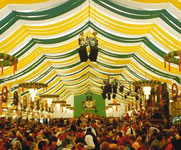
At first, the young Sisi found it difficult to deal with strict court etiquette and the loss of her privacy, but over time she developed into a confident, energetic woman who asserted herself against the constraints of court life and led life in her own way. Sisi also frequently stayed at a baroque palace known as the "Blauer Hof" (Blue Court) in Laxemburg near Vienna where her only son Rudolph, the heir to the Austrian throne was born on 21 August 1858. This was the Habsburgs' favourite summer residence and today visitors can tour the "Elisabeth apartments" and explore the romantic palace gardens laid out in the English landscape garden style, where the empress used to stroll. Elisabeth was not only empress of Austria: in June 1867 she was also crowned queen of Hungary in St Matthew's Church in Budapest. In stark contrast to the restricted life she led at the Viennese court and at Schönbrunn Palace, Sisi was very fond of her stays in Hungary.

The new queen spent about 2,000 nights of her life at Godollo Palace, "Hungary's Versailles" located 28km north-east of Budapest, which was presented to her and her husband Franz Joseph by the Hungarian people on the occasion of their joint coronation. In 1870, for the first time, Elisabeth avoided the winter cold in the mild climate of Trauttmansdorff Castle near Merano in Italy. The empress liked the castle, and the area, so much she even considered buying it. Today Trauttmansdorff Castle gardens are still remarkable for their mediterranean-like feel. This account contains just a small number of places associated with the beloved monarch, but a tour of everywhere this extraordinary woman passed her life will take you to fascinating castles and palaces, museums and squares, all with a story to tell of the life and fate of the famous empress of Austria and queen of Hungary. They form an impressive record of Elisabeth, whose allure is still palpable more than one hundred years after her death.








